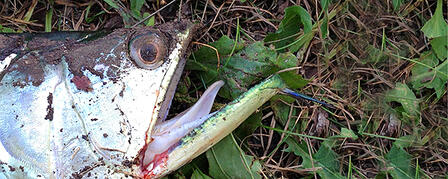LAKE SHAWNEE ANGLER CATCHES ALIEN FISH

July 25, 2013
KDWPT advises anglers who catch exotic fish to not return them to water
TOPEKA– An unidentified angler landed quite a surprise at Lake Shawnee in Topeka Sunday, July 21, when he hauled in a silver arowana, a primitive freshwater fish native to the Amazon River Basin in South America. Often kept as aquarium pets, arowanas do not belong in Kansas waters. The fish was about 20 inches long and was likely released into Lake Shawnee or upstream by someone who could no longer care for it. Sold as youngsters, arowanas can grow to 2 feet long or more in captivity and can quickly outgrow their aquariums. They grow to nearly 4 feet long in the wild. Arowanas are aggressive and carnivorous, and they may eat other aquarium fish.
Jessica Howell, aquatic nuisance species coordinator for the Kansas Department of Wildlife, Parks and Tourism (KDWPT), cautioned that people should not release aquarium animals into the wild. “It’s against state and federal law to release any exotic species into Kansas waters, and new regulations also make it illegal to dump any fish into waters where they don’t originate,” she said. “Responsible aquarium owners never release anything, including water, plants, snails and fish into a stream, pond, lake, ditch or storm drain.”
The angler who caught the fish asked Torrey Bevans, who was fishing nearby, for help. Bevans photographed the fish so it could be identified and correctly advised the angler to not return the fish to the lake. The fish died on the bank, although it took some time, as arowanas can get oxygen by drawing air into their swim bladders. Bevans visited a KDWPT office in Topeka on Monday to report the catch and share his photos.
Howell said Bevans gave the correct advice. “If you catch an exotic fish, do not return it to the water. Instead, let it die and photograph it or put it on ice for later identification by a KDWPT biologist. If you own exotic fish, visit ProtectKSWaters.org for suggestions on responsibly handling unwanted aquarium specimens so you don’t break the law.”
With sharply upturned lower jaws and eyes high on the sides of their heads, arowanas are specialized for feeding at the surface where they pick off insects, small fish and other animals. Two barbels (“whiskers”) on their lower jaws help arowanas sense movement and locate prey in murky water. Sometimes called monkey fish or water monkeys, they are spectacular jumpers in their native waters and can leap up to 6 feet out of the water to catch birds, snakes or frogs.
For information on aquatic nuisance species, visit ProtectKSWaters.org.
Photo courtesy of Torrey Bevans.
-30-









